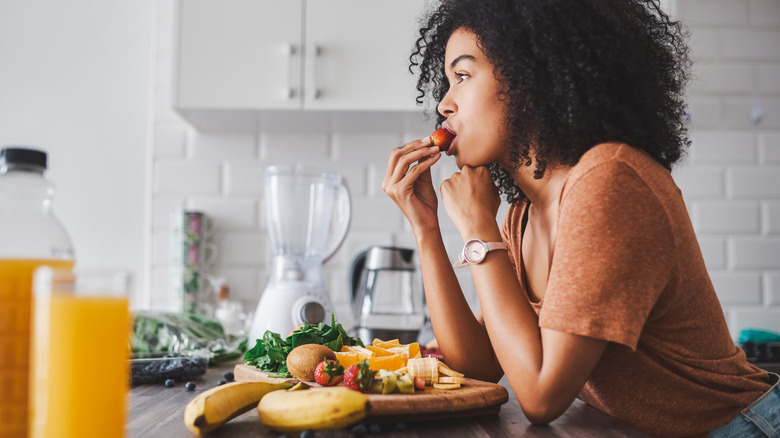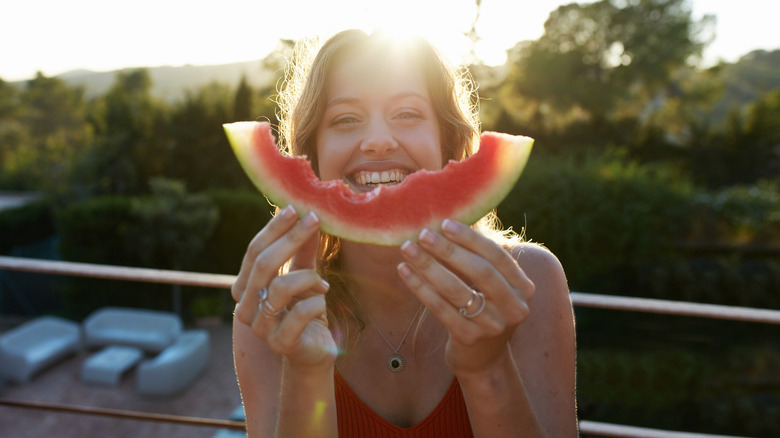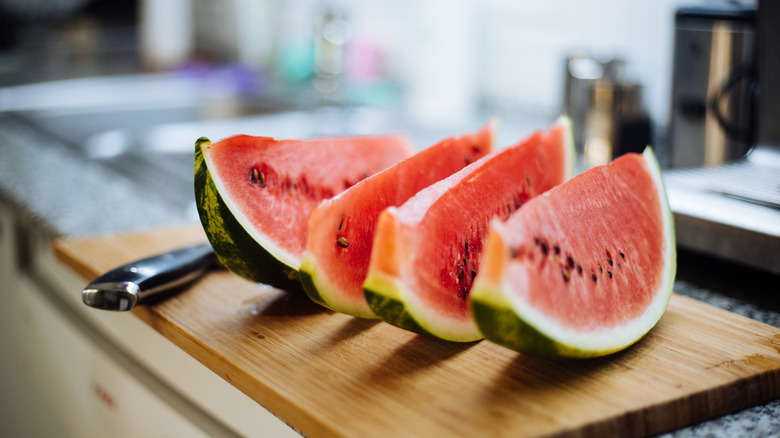The Refreshing Fruit That Has More Potassium Than A Banana
Potassium does a lot for your body. From regulating your heartbeat and keeping your blood pressure at a healthy state to promoting healthy muscles and nerves and preventing strokes, this electrolyte is an important element in overall cell function in your body, as explained by Harvard Health.
New York-based registered dietitian Rachael Link shared that healthy potassium intake can reduce the appearance of cellulite and even ward off osteoporosis (via Dr. Axe). Given all these benefits, it is no wonder that doctors jump straight to the advice of "eat a banana every day" as a cure for when your muscles are cramping or when you need some additional potassium for heart health. One medium banana (118 grams) contains 420 milligrams of potassium, per the U.S. Department of Agriculture, and we need anywhere between 3,500 milligrams and 4,700 milligrams daily.
Turns out, there's another fruit that contains even more potassium than bananas: the refreshing summertime favorite — watermelon. If you were to consume two wedges of delicious and juicy fruit, you'd be getting as much as 640 milligrams of potassium. Watermelons are easy to eat because all you have to do is slice them up and they're ready to go. Also, potassium isn't the only benefit this fruit offers.
Watermelons are good sources of vitamins A and C, and lycopene
If you want healthy eyes and skin, regularly consuming watermelon, which is high in vitamins A and C, can be good for you, per Web MD. Additionally, the fruit's beta-cryptoxanthin properties can protect your joints from inflammation.
What stands out, probably the most, is how rich a source of lycopene this fruit is. It ranks number three on a list of top 10 foods highest in lycopene, under guavas and tomatoes, according to My Food Data. In addition to reducing the risk of cancer, heart disease, and diabetes, lycopene helps with sun protection as well.
Registered dietician and board-certified specialist in renal nutrition Lauren Gleason told Kidney Foodie, "Watermelon is considered a low oxalate food, so if you're prone to kidney stones and you're trying to limit your oxalate intake, then watermelon is safe to eat." Now that you know about this fruit that's got even more potassium than the humble banana, here's how you can enjoy it.
Different ways to consume watermelon
As we said before, you usually won't require any fancy recipes when it comes to a watermelon. Simply choose one that's not dented, yellow at the bottom, heavy, and hollow-sounding when knocked, noted Web MD. Go for the red and ripe flesh, then slice the fruit into generous chunks and enjoy. You may want to sit somewhere comfortable and have a napkin spread out on your lap, though, because eating this refreshing snack can get a little messy.
Pay attention to just how much you're consuming, warned Gleason (via Kidney Foodie). "If you sit down and eat a half a watermelon, you'll be consuming an estimated 2000 milligrams of potassium, which is a lot of potassium. So be mindful of your portion sizes when you're enjoying watermelon," she added. There is such a thing as too much potassium, which can lead to irregular heartbeats, muscle pains, chest pains, and trouble breathing.
If you're looking to add watermelon to recipes, they taste great in salads, smoothies, and even cocktails. Or you can turn to the summer favorite watermelon popsicle. There's even a watermelon and banana combination you can try courtesy of Nutrition in the Kitch. You'll need some watermelon pieces, frozen bananas, chia seeds, and unsweetened vanilla almond milk. Oat or soy is fine too. Blend together, sprinkle chia seeds on top, and enjoy. Throw in some protein powder if you're whipping this up as a post-workout smoothie.


